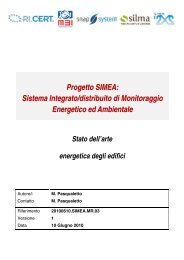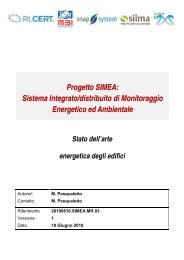Lezione 23 — 07 Dicembre 23.1 Unscented Kalman filter - Automatica
Lezione 23 — 07 Dicembre 23.1 Unscented Kalman filter - Automatica
Lezione 23 — 07 Dicembre 23.1 Unscented Kalman filter - Automatica
You also want an ePaper? Increase the reach of your titles
YUMPU automatically turns print PDFs into web optimized ePapers that Google loves.
PSC: Progettazione di sistemi di controllo I Sem. 2010<br />
<strong>Lezione</strong> <strong>23</strong> <strong>—</strong> <strong>07</strong> <strong>Dicembre</strong><br />
Docente: Luca Schenato Stesore: Alberton R., Ausserer M., Barazzuol A.<br />
<strong>23</strong>.1 <strong>Unscented</strong> <strong>Kalman</strong> <strong>filter</strong><br />
Si continua ora con l’unscented <strong>Kalman</strong> <strong>filter</strong> (UKF) visto nella lezione precedente. In<br />
particolare, il filtro UKF si basa su un metodo per l’approssimazione di densità di probabilità<br />
ottenute tramite l’applicazione di mappe non lineari a v.a. statiche. Questo metodo e’ poi<br />
applicato in maniera iterativa per ottenere un’approssimazione in sistemi dimanici.<br />
<strong>23</strong>.1.1 Trasformazioni nonlineari statiche di variabili aleatorie<br />
Il procedimento dell’UKF consta di tre passaggi. Nel primo la variabile casuale x viene<br />
approssimata da 2N + 1 punti vi pesati da dei pesi wi scelti in modo tale che media e<br />
varianza coicidano con quelle originali di x. Nel secondo passo si mappano questi punti<br />
attraverso la funzione non lineare g(x). Infine i punti mappati vengono approssimati con un<br />
opportuna gaussiana.<br />
Si ha:<br />
px(·) ∼ N(¯x, Px) y = g(x)<br />
e si approssima la py con una gaussiana ottenendo:<br />
λ u<br />
i i<br />
py(·) ≃ N(¯y, Py)<br />
g(x)<br />
Figura <strong>23</strong>.1. Procedimento dell’<strong>Unscented</strong> <strong>Kalman</strong> Filter<br />
<strong>23</strong>-1<br />
media pesata<br />
vazianza
PSC <strong>Lezione</strong> <strong>23</strong> <strong>—</strong> <strong>07</strong> <strong>Dicembre</strong> I Sem. 2010<br />
1. Da px(·) ∼ N(¯x, Px) si generano 2N + 1 punti (dove x ∈ R N ) nel modo seguente:<br />
• v0 = ¯x<br />
• v1 = ¯x + ασ1<br />
• v2 = ¯x − ασ1<br />
.<br />
• v2N−1 = ¯x + ασN<br />
• v2N = ¯x − ασN<br />
dove α è un fattore di scala che viene imposto in modo che la media campionaria dei vi<br />
risulti pari a ¯x e la varianza campionaria degli vi pari a Px. Il calcolo di α si comincia<br />
fattorizzando la varianza di x Px = UDU T , con U = [u1, . . .,uN] una matrice di vettori<br />
ui ortonormali e D la matrice diagonale<br />
⎡ ⎤<br />
D =<br />
⎢<br />
⎣<br />
λ1<br />
Si puó scrivere la Px nel modo seguente:<br />
Px = UDU T<br />
⎡<br />
= ⎢<br />
u1 . . . uN ⎣<br />
√ λ1<br />
. ..<br />
λN<br />
. ..<br />
⎥⎢<br />
⎦⎣<br />
√λN<br />
⎥<br />
⎦ ≥ 0<br />
⎤⎡<br />
= √ λ1u1 . . . √ ⎡ √<br />
λ1u<br />
⎢<br />
λNuN ⎣<br />
T 1<br />
√<br />
.<br />
λNuT ⎤<br />
⎥<br />
⎦<br />
N<br />
= λ1u1u T 1 + . . . + λNuNu T N .<br />
√ λ1<br />
⎤⎡<br />
u T 1<br />
. ..<br />
⎥⎢<br />
⎦⎣<br />
.<br />
√λN<br />
Chiamando σi = √ λiui (vedi vettore rosso in Figura <strong>23</strong>.1) si ha che Px = N<br />
i=1 σiσ T i .<br />
La densitá di probabilitá di x puó essere approssimata nel modo seguente:<br />
con i pesi<br />
px(·) ≃<br />
2N<br />
i=0<br />
wiδ(x − vi) = ˆpx(·)<br />
w1 = w2 = . . . = w2N =<br />
w0 = 1 −<br />
2N<br />
i=1<br />
wi = 1 − N<br />
N + κ<br />
<strong>23</strong>-2<br />
1<br />
2(N + κ)<br />
= κ<br />
N + κ .<br />
u T N<br />
⎤<br />
⎥<br />
⎦
PSC <strong>Lezione</strong> <strong>23</strong> <strong>—</strong> <strong>07</strong> <strong>Dicembre</strong> I Sem. 2010<br />
Vengono ora calcolate la media e la varianza di x relative alla densitá di probablitá<br />
approssimata:<br />
<br />
Eˆpx[x] =<br />
2N<br />
x i=0<br />
xwiδ(x − vi)dx =<br />
V arˆpx(x) = Eˆpx[(x − ¯x)(x − ¯x) T <br />
] =<br />
<br />
=<br />
ξ<br />
2N<br />
i=0<br />
= α2<br />
N + κ<br />
2N<br />
i=0<br />
2N<br />
x i=0<br />
ξξ T wiδ(ξ + ¯x − vi)dξ =<br />
N<br />
i=1<br />
σiσ T i<br />
= α2<br />
N + κ Px<br />
wivi = ¯x<br />
2N<br />
i=0<br />
wi = ¯x<br />
(x − ¯x)(x − ¯x) T wiδ(x − vi)dx,<br />
N<br />
i=1<br />
1<br />
2(N + κ) 2α2 σiσ T i<br />
avendo effettuato il cambio di variabili ξ = x − ¯x. Poiché si vuole imporre che<br />
V arˆpx(x) = Px si determina α = √ N + κ.<br />
2. Al secondo passo si devono mappare le vi usando la funzione non lineare g(·) ottenendo<br />
così yi = g(vi) con i = 0, . . ., 2N. La densitá di probabilitá approssimata di y risulta<br />
essere<br />
py(·) ≃<br />
2N<br />
i=0<br />
wiδ(y − yi) = ˆpy(·)<br />
3. Al terzo passo si effettuano le seguenti approssimazioni:<br />
ˆpy(·) = N(¯y, Py) ∼ = ˆpy(·), ¯y := Eˆpy[y] =<br />
Py := V arˆpy(y) = Eˆpy[(y − ¯y)(y − ¯y) T ] =<br />
2N<br />
wiyi<br />
i=0<br />
N<br />
wi(y − ¯y)(y − ¯y) T ≥ 0<br />
Tutti i tre passaggi precedenti dovrebbero garantire, almeno sotto opportune ipotesi,<br />
che<br />
ˆpy(·) ∼ = py(·) .<br />
<strong>23</strong>.1.2 Filtro di <strong>Kalman</strong> <strong>Unscented</strong><br />
Fino ad ora si sono mappate densità di probabilità in densità di probabilità e le abbiamo<br />
approssimate con delle gaussiane.<br />
<br />
x µx Px Pxy<br />
∼ N( , )<br />
y<br />
µy<br />
<strong>23</strong>-3<br />
P T xy Py<br />
i=0
PSC <strong>Lezione</strong> <strong>23</strong> <strong>—</strong> <strong>07</strong> <strong>Dicembre</strong> I Sem. 2010<br />
con<br />
Pxy = cov(x, y) ∼ =<br />
N<br />
wi(vi − ¯x)(yi − ¯y) T<br />
i=1<br />
x|y ∼ N(µx + PxyP −1<br />
y (y − µy), Px − PxyP −1<br />
y P T xy )<br />
Si cerca ora di applicare quanto visto al modello dinamico non lineare:<br />
xk+1 = f(xk, uk, wk)<br />
yk = h(xk, vk)<br />
Non essendo necessariamente wk e vk gaussiani questi vengono approssimati nel modo seguente:<br />
wk ∼ pw(·) ∼ = N( ¯w, Pw)<br />
e dunque si può scrivere y = g(ξ) con<br />
⎡<br />
ξ = ⎣<br />
xk<br />
wk<br />
vk<br />
⎤ ⎡ ⎤<br />
ˆxk|k<br />
⎦ ∼ N( ⎣ ¯w ⎦,<br />
¯v<br />
vk ∼ pv(·) ∼ = N(¯v, Pv)<br />
xk ∼ = N(ˆxk|k, Pk|k)<br />
xk ⊥vk ⊥wk<br />
⎡ ⎤<br />
Pk|k 0 0<br />
⎣ ⎦) ,<br />
0 Pw 0<br />
0 0 Pv<br />
⎧<br />
⎪⎨<br />
⎪⎩<br />
x ∈ R n<br />
y ∈ R m<br />
w ∈ R p<br />
v ∈ R q<br />
ξ ∈ R n+p+q = R N<br />
Si dovranno dunque generare 2N + 1 punti vi = 0, 1, . . ., 2N con i pesi<br />
1<br />
wi =<br />
2(N + κ)<br />
w0 = κ<br />
N + κ .<br />
i = 0<br />
E ora per calcolare ˆxk+1|k+1 ho bisogno di ˆxk+1|k, ˆyk+1|k, P x y xy<br />
k+1|k , Pk+1|k , Pk+1|k , infatti:<br />
ˆxk+1|k+1 = ˆxk+1|k − P xy y<br />
k+1|k (Pk+1|k )−1 (yk+1 − ˆyk+1|k) (<strong>23</strong>.1)<br />
<strong>23</strong>-4
PSC <strong>Lezione</strong> <strong>23</strong> <strong>—</strong> <strong>07</strong> <strong>Dicembre</strong> I Sem. 2010<br />
e calcolando:<br />
ˆxk+1|k =<br />
2N<br />
i=0<br />
P x k+1|k =<br />
2N<br />
wif(v x i , u x k, w w i )<br />
wi(f(v x i , uk, w w i ) − ˆxk+1|k)(f(v x i , uk, w w i<br />
i=0<br />
2N<br />
ˆyk+1|k = wih(ˆx i k+1|k , vv i )<br />
P y<br />
k+1|k =<br />
P xy<br />
k+1|k =<br />
i=0<br />
2N<br />
wi(ˆy i k+1|k − ˆyk+1|k)(ˆy i k+1|k − ˆyk+1|k) T<br />
i=0<br />
2N<br />
wi(ˆx i k+1|k − ˆxk+1|k)(ˆy i T<br />
k+1|k − ˆyk+1|k)<br />
i=0<br />
) − ˆxk+1|k) T<br />
si hanno tutti i termini necessari per implementare la (<strong>23</strong>.1).<br />
Si noti come in questo caso non è necessario linearizzare ad ogni passo la matrice come<br />
nel caso del filtro esteso e si approssimano distribuzioni piuttosto che non linearità. Inoltre<br />
con questo metodo si ottiene una precisione del secondo ordine senza calcolare hessiani o<br />
jacobiani. I pesi possono poi essere scelti in modo tale da catturare statistiche di ordine più<br />
elevato.<br />
Tuttavia nell’implementazione UKF si rende necessario diagonalizzare la matrice di varianza<br />
di ξ al variare di Pk|k. Per rendere meno oneroso questo calcolo si può usare la Squared<br />
UKF (che utilizza la fattorizzazione di Cholesky), chiamando Q fattorizzazione di Cholesky<br />
di P si può scrivere:<br />
⎡ ⎤<br />
v T 1<br />
P = QQ T = ⎢<br />
v1 . . . vN ⎣ .<br />
v T N<br />
⎥<br />
⎦ =<br />
dove Q è triangolare e risulta numericamente più facile da calcolare rispetto alla diagonalizzazione<br />
di P tramite la decomposizione ai valori singolari (SVD).<br />
<strong>23</strong>.2 Confronto tra UKF e EKF: esempio scalare<br />
Si consideri la seguente mappa lineare, che mappa una v.a. gaussiana in un’altra v.a.:<br />
y = x 2 , x ∈ R, x ∼ N(¯x, σ 2 x )<br />
<strong>23</strong>-5<br />
N<br />
i=0<br />
viv T i
PSC <strong>Lezione</strong> <strong>23</strong> <strong>—</strong> <strong>07</strong> <strong>Dicembre</strong> I Sem. 2010<br />
p<br />
x<br />
x<br />
σ 2<br />
x<br />
x<br />
g(.)=(.) 2<br />
Figura <strong>23</strong>.2. Procedimento del filtro UKF<br />
Rappresentando x come x := ¯x+δx con δx ∼ N(0, σ2 x ) si calcolano la media e la varianza<br />
esatta di y:<br />
¯yT = Ey[y] = Ex[x 2 ] = Ex[(¯x + δx) 2 ]<br />
= E[¯x 2 + 2¯xδx + (δx) 2 ]<br />
= ¯x 2 + σ 2 x<br />
(σ 2 y)T = V ar(y) = E[(x 2 − (¯x 2 + σ 2 x) 2 ) 2 ]<br />
= E[4¯x 2 (δx) + (δx) 4 + σ 4 x + 4¯x(δx) 3 − 4¯xσ 2 xδx − 2(δx) 2 σ 2 x]<br />
= 4¯x 2 σ 2 x + E[(δx) 4 ] + σ 4 x − 2σ 4 x<br />
= 2σ 4 x + 4¯x2 σ 2 x<br />
dove nell’ultimo passaggio si è sfruttato il fatto che E[(δx) 4 ] = 3σ4 x . L’esempio prosegue<br />
nella prossima lezione.<br />
<strong>23</strong>-6<br />
p<br />
y<br />
y
Bibliografia<br />
[1] Giorgio Picci. Fitraggio Statistico (Wiener, Levinson, <strong>Kalman</strong>) e Applicazioni. Libreria<br />
Progetto, 2006.<br />
[2] J. Uhlmann S. Julier. A general method for approximating nonlinear transformations of<br />
probability distributions. Technical report, University of Oxford, 1996.<br />
[3] E. Wan R. van der Merwe. Sigma-point kalman <strong>filter</strong>s for integrated navigation.<br />
Proceedings of the 60th Annual of the Institute of Navigation, 2004.<br />
[4] G. Oriolo P. Peliti T. Fiorenzani, C. Manes. Comparative study of unscented kalman<br />
<strong>filter</strong> and extended kalman <strong>filter</strong> for position/attitude estimation in unmanned aerial<br />
vehicles. Technical report, IASI CNR, 2002.<br />
7

















